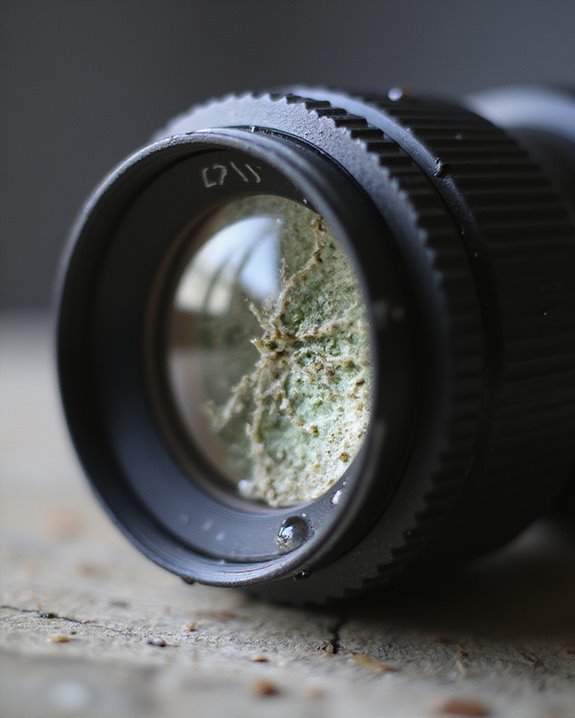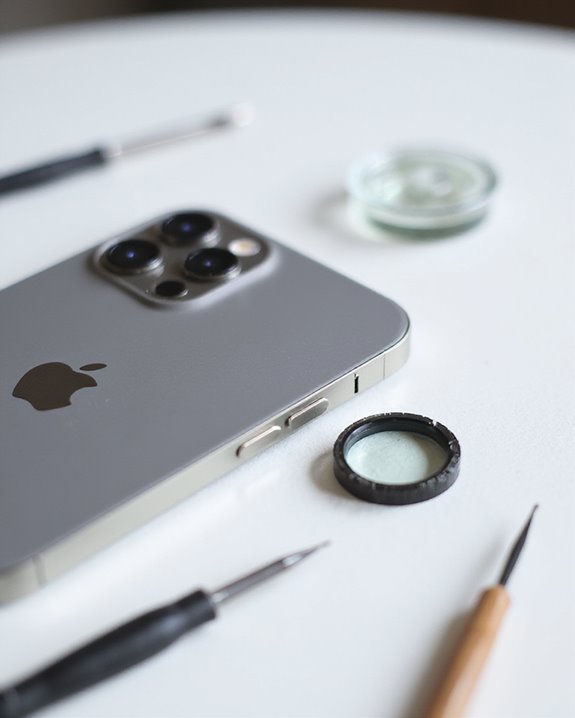Camera lens fungus forms mainly under environmental conditions combining 10°C–35°C temperatures with relative humidity above 70%, which facilitate airborne spore settlement and activation on optical surfaces. Adhesive degradation within lens assemblies supplies organic substrates that support fungal growth primarily from Ascomycota and Fungi Imperfecti taxa, producing hydrofluoric acid that chemically etches glass and compromises image clarity by 15–25%. Structural damage includes lens cement deterioration and obstruction of light transmission up to 30%, all causing permanent optical degradation. Subsequent sections detail identification, ecological factors, and mitigation techniques.
Key Takeaways
- High humidity and temperatures between 10°C and 35°C create ideal conditions for fungal spores to germinate on camera lenses.
- Moisture accumulation inside lenses, often due to poor storage or condensation, activates fungal growth on optical elements.
- Organic residues and breakdown of adhesive materials inside lenses provide nutrients for fungi to thrive and spread.
- Airborne fungal spores settle on lens surfaces, especially in environments near water sources or dust, increasing infection risk.
- Sealed, unventilated storage traps moisture and heat, fostering fungal colonization and subsequent lens damage.
Causes of Fungus Formation in Camera Lenses
The formation of fungus in camera lenses primarily results from the interaction of environmental and material factors that create a conducive habitat for fungal proliferation. Spore origins are chiefly airborne fungal spores which settle on lens surfaces, with high humidity and temperature accelerating spore germination. Moisture accumulation facilitates fungal growth by activating spores deposited on optical elements. Adhesive breakdown within lens assemblies, particularly in cemented lenses, contributes substantially by releasing organic substrates that fungi metabolize. This degradation of adhesives, compounded by dust accumulation containing spores, provides both nutrients and anchorage for fungal colonies. Poor storage conditions, such as sealed environments with inadequate desiccation, exacerbate moisture retention, promoting fungal infestation. Collectively, these factors establish an environment favorable to mycelial expansion, compromising lens coatings and optical clarity, necessitating stringent environmental control and material integrity to mitigate fungal colonization risks.
Types of Fungi That Affect Camera Optics

Various fungal taxa exhibit the capacity to colonize camera optics, primarily influenced by environmental humidity, temperature, and the availability of organic substrates within lens assemblies. Chiefly, species from the Ascomycota phylum, including filamentous genera *Penicillium* and *Aspergillus*, demonstrate invasive growth patterns characterized by radial hyphal networks and enzymatic degradation of lens coatings. The Fungi Imperfecti subgroup, defined by asexual reproduction and ambiguous fungal genetics, dominates infestations due to adaptive metabolic pathways producing hydrofluoric acid, which etches glass surfaces. Oomycetes, though less frequent, contribute cotton-like biofilms under high moisture conditions. Species origins are heterogeneous, deriving from environmental spores and residual organic films. Identification complexity arises from multi-strain coexistence and morphological mimics, necessitating disassembly for definitive diagnosis. Collectively, these fungal taxa inflict irreversible optical damage through cement layer penetration and coating degradation, compromising image fidelity.
Environmental Conditions That Promote Lens Fungus
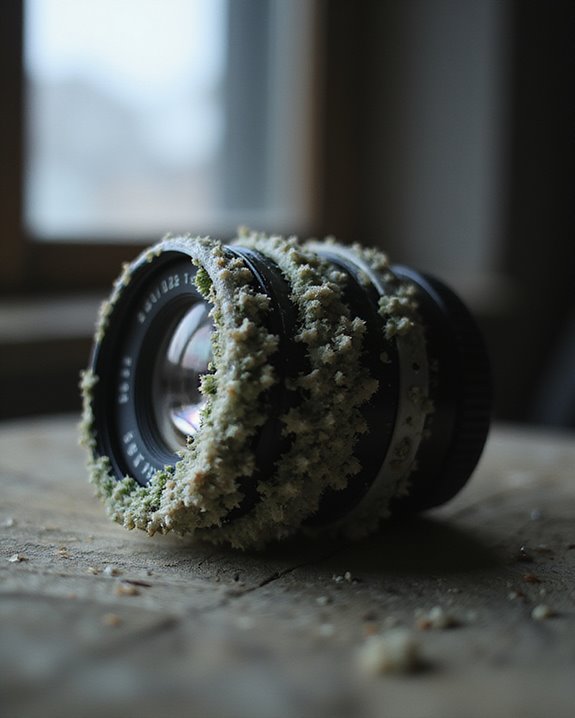
Environmental parameters exert significant influence on the proliferation of fungal colonies within camera lenses, with temperature, humidity, and storage conditions serving as critical determinants. Regional climates characterized by hot temperatures between 10°C and 35°C combined with relative humidity exceeding 70% for extended periods significantly increase fungal risk. Seasonal variations further modulate these conditions; humid seasons induce moisture accumulation, while rapid temperature fluctuations promote condensation conducive to fungal growth. Storage environments lacking ventilation or airflow exacerbate moisture retention, especially in airtight containers or dark, unmonitored areas. Conversely, maintaining consistent temperatures below 50°C, relative humidity under 60%, and employing breathable storage with desiccants diminish fungal colonization probability. Proximity to water sources and accumulation of organic nutrients such as dust also elevate risk. Additionally, the use of specialized lens bags with moisture control features can greatly help prevent fungal development. Therefore, environmental control tailored to regional and seasonal factors is essential for mitigating lens fungus development.
How Fungus Damages Camera Lens Components
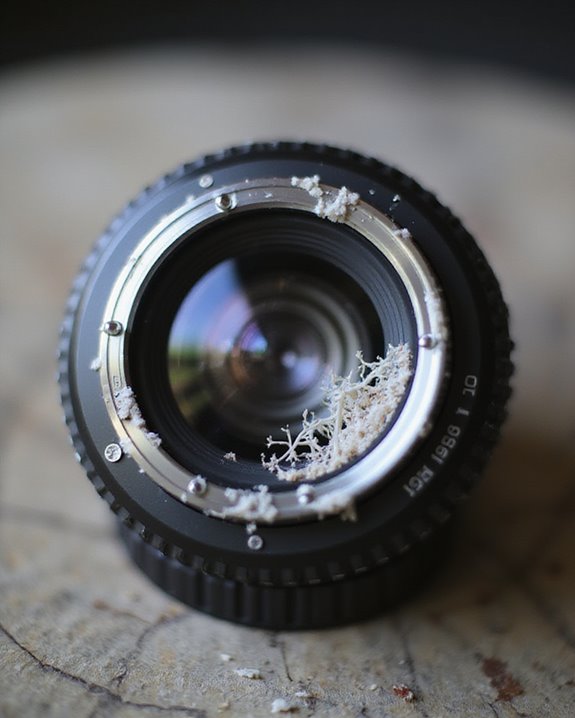
How does fungal colonization compromise the integrity and performance of camera lenses? Fungal organisms generate hydrofluoric acid as a metabolic byproduct, whose acid effects induce irreversible etching of glass elements and degradation of protective coatings. This chemical corrosion reduces optical clarity by increasing light scattering and flare, measurable as a 15–25% decrease in image contrast. Concurrently, consumption of organic lens cement causes structural weakness, physically disrupting element alignment and mechanical stability, thereby impairing focus precision. Internal fungal webs further obstruct light transmission, producing haze and brightness loss quantified up to 30% under laboratory photometric analysis. These combined acid effects and structural weaknesses result in permanent optical damage that cleaning cannot reverse, greatly diminishing lens performance and resale value. The progressive nature of fungal damage underscores the necessity for preventive storage and maintenance protocols to preserve lens functionality. Additionally, the use of anti-magnetic stainless steel tools can aid in careful inspection and cleaning to prevent further contamination.
Signs of Fungus Growth on Camera Lenses
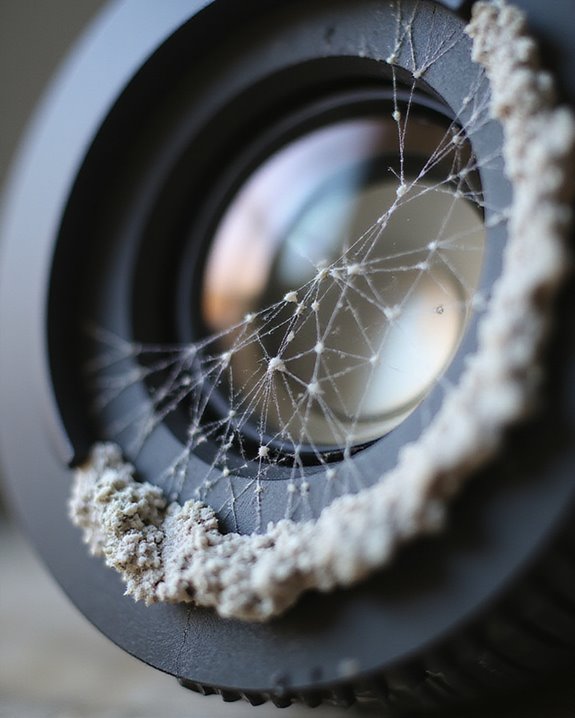
Signs of fungal growth on camera lenses manifest through distinct visual and structural indicators that can be systematically identified via inspection techniques. Fungus typically appears as small, web-like spots or patches within lens elements, exhibiting growth patterns such as spider-like or snowflake formations, often originating from edges or central points. Visual inspection under normal light reveals tiny white or fluffy dots; magnification enhances detection accuracy. Flashlight tests amplify fungal visibility due to refractive light scattering. Case studies demonstrate that misinterpretation of fungus as dust or haze underlies common Fungus Myths, emphasizing the necessity of precise diagnostic methods. Differentiation from other optical anomalies requires systematic evaluation, considering growth morphology, response to illumination, and lens storage conditions. Accurate identification is imperative to assess potential impact on optical integrity and inform maintenance protocols.
Challenges in Removing Fungus From Lenses
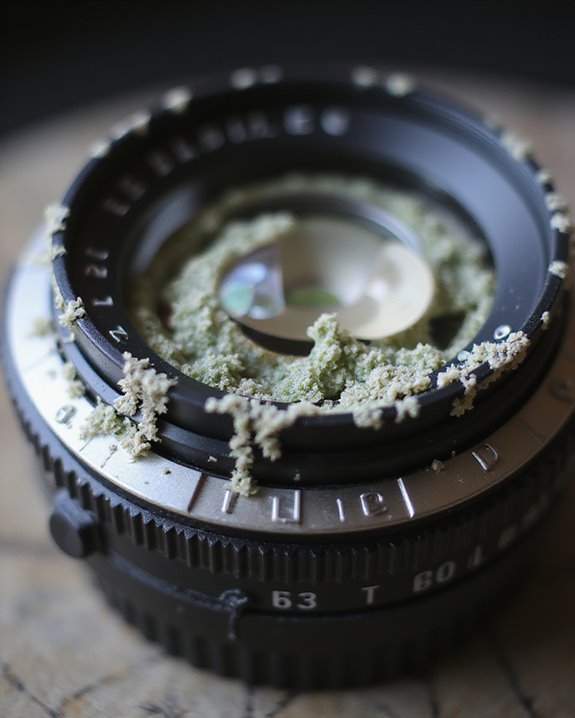
The removal of fungal growth from camera lenses presents multifaceted challenges rooted primarily in the intricacy of lens construction and the biological resilience of fungal organisms. Effective cleaning necessitates complete lens disassembly, requiring specialized tool requirements such as lens spanner wrenches and vacuum pads to prevent mechanical damage. Cost factors escalate due to the labor-intensive process and the need for professional expertise, particularly when addressing compound glued elements vulnerable to adhesive weakening. Chemical cleaning solutions, including 3% hydrogen peroxide, demand precise application to avoid irreversible etching of lens glass and coatings. Moreover, complete eradication is impeded by fungal spore persistence in micro-crevices, often necessitating repeated cleaning cycles and controlled drying. Additionally, cleaning kits often include alcohol-free solutions and microfiber cloths designed to prevent streaks and damage during cleaning. Collectively, these challenges result in significant time investment, limited accessibility to appropriate tools, and elevated costs, complicating restoration efforts and influencing decisions between repair and lens replacement.
Preventative Measures to Avoid Lens Fungus
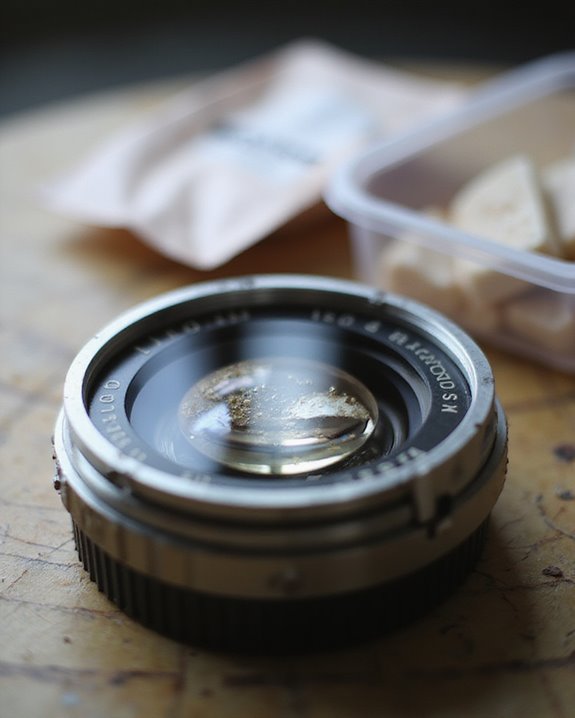
Preventative measures against the development of fungus within camera lenses necessitate rigorous control of environmental variables and meticulous handling protocols. Maintaining relative humidity below 65% and stable temperatures inhibits fungal spore germination effectively. Implementation of silica alternatives, such as high-capacity desiccants with monitored saturation indicators, enhances moisture absorption beyond conventional silica gel packets. Use of antifungal wipes for routine lens surface cleaning mitigates organic residues that serve as fungal nutrients, complementing drying procedures that utilize airflow to prevent moisture retention. Avoidance of sealed, non-ventilated enclosures reduces stagnant air accumulation, a critical factor in fungal proliferation. Periodic exposure to controlled ultraviolet light and incorporation of fungicidal inserts add supplementary layers of defense. Collectively, these measures, grounded in empirical humidity thresholds and material efficacy, constitute a thorough preventative strategy against lens fungus formation.
Proper Storage and Maintenance to Protect Lenses
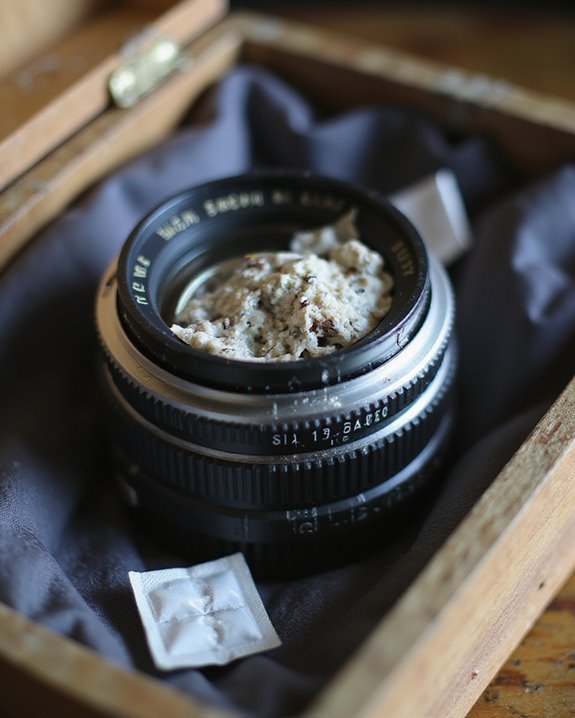
Effective protection of camera lenses from fungal contamination necessitates stringent adherence to proper storage and maintenance protocols that optimize environmental conditions and handling procedures. Lens cases constructed from non-porous materials, preferably sealed containers equipped with adequate silica gel, greatly reduce relative humidity below the critical 65% threshold, thereby inhibiting fungal proliferation. Utilization of UV filters provides a secondary defense by mitigating fungal spore germination through controlled ultraviolet exposure without damaging lens coatings. Maintenance routines involving frequent cleaning with lint-free microfiber cloths, combined with immediate moisture removal and air circulation, prevent residual dampness conducive to fungal growth. Storage environments incorporating air conditioning, dehumidifiers, and fungicidal pellets demonstrate superior stability in temperature and humidity, essential for long-term lens preservation. Avoidance of organic container materials, such as wood or leather, further minimizes nutrient availability for fungal development, ensuring ideal lens integrity.
Frequently Asked Questions
Can Lens Fungus Spread to Other Camera Equipment?
Fungus transfer between camera equipment occurs through direct contact or shared cleaning materials, leading to equipment contamination. Proper storage and isolation of infected lenses are essential to prevent fungal spores from spreading to other camera components.
Is Lens Fungus Harmful to Human Health or Skin?
Lens fungus poses minimal health risks, with no significant skin effects reported. However, inhaling airborne fungal spores may trigger respiratory issues or allergies, particularly in sensitive individuals, emphasizing the importance of clean equipment and proper handling.
How Long Does It Take for Lens Fungus to Develop Inside a Lens?
In a humid tropical environment, a lens exhibited visible fungus within seven weeks. Humidity impact accelerates growth, while temperature role influences fungal metabolism, with warmer climates promoting faster development inside lenses under favorable conditions.
Can Professional Lens Cleaning Completely Restore Fungus-Damaged Lenses?
Professional lens cleaning can effectively remove visible fungus using specialized restoration techniques; however, complete restoration is limited by damage severity. Cleaning alternatives exist but cannot reverse etching or optical degradation caused by prolonged fungal infestation.
Are Certain Camera Brands More Prone to Lens Fungus Than Others?
Brand ratings show no significant difference in lens fungus susceptibility. Material differences, such as organic components and sealing quality, influence risk more than brand. Environmental factors remain the primary determinant of fungal growth on camera lenses.

